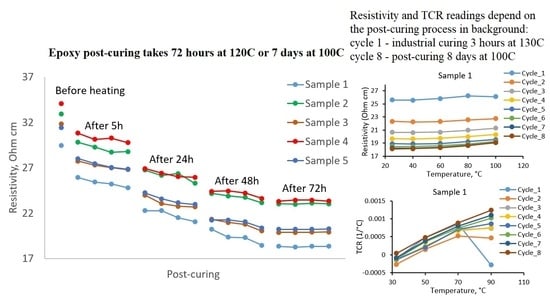Separating Curing and Temperature Effects on the Temperature Coefficient of Resistance for a Single-Walled Carbon Nanotube Nanocomposite
Abstract
1. Introduction
2. Materials and Methods
2.1. Materials
2.2. Samples’ Fabrication
2.3. Electrical Resistance Measurements at Post-Curing
3. Results and Discussion
3.1. Electrical Resistivity Change during Uninterrupted Post-Curing
3.2. Changes in Electrical Resistivity with Temperature at Different Post-Curing States
4. Comparative Analysis
5. Conclusions
Author Contributions
Funding
Data Availability Statement
Conflicts of Interest
References
- Ma, C.; Liu, H.-Y.; Du, X.; Mach, L.; Xu, F.; Mai, Y.-W. Fracture resistance, thermal and electrical properties of epoxy composites containing aligned carbon nanotubes by low magnetic field. Compos. Sci. Technol. 2015, 114, 126–135. [Google Scholar] [CrossRef]
- Sabu, M.; Bementa, E.; Ruban, Y.J.V.; Mon, S.G. A novel analysis of the dielectric properties of hybrid epoxy composites. Adv. Compos. Hybrid Mater. 2020, 3, 325–335. [Google Scholar] [CrossRef]
- Gong, S.; Zhu, Z.H. Giant piezoresistivity in aligned carbon nanotube nanocomposite: Account for nanotube structural distortion at crossed tunnel junctions. Nanoscale 2015, 7, 1339–1348. [Google Scholar] [CrossRef] [PubMed]
- Butt, H.A.; Lomov, S.V.; Akhatov, I.S.; Abaimov, S.G. Self-diagnostic carbon nanocomposites manufactured from industrial epoxy masterbatches. Compos. Struct. 2021, 259, 113244. [Google Scholar] [CrossRef]
- Hu, N.; Karube, Y.; Arai, M.; Watanabe, T.; Yan, C.; Li, Y.; Liu, Y.; Fukunaga, H. Investigation on sensitivity of a polymer/carbon nanotube composite strain sensor. Carbon 2010, 48, 680–687. [Google Scholar] [CrossRef]
- Ge, L.; Gong, X.; Wang, Y.; Xuan, S. The conductive three dimensional topological structure enhanced magnetorheological elastomer towards a strain sensor. Compos. Sci. Technol. 2016, 135, 92–99. [Google Scholar] [CrossRef]
- Yang, W.; Zou, W.; Du, Z.; Li, H.; Zhang, C. Enhanced conductive polymer nanocomposite by foam structure and polyelectrolyte encapsulated on carbon nanotubes. Compos. Sci. Technol. 2016, 123, 106–114. [Google Scholar] [CrossRef]
- Lomov, S.V.; Abaimov, S.G. Influence of the Nanostitch Sensor Embedment on the Fibrous Microstructure of Glass Fiber Prepreg Laminates. Polymers 2022, 14, 4644. [Google Scholar] [CrossRef]
- Lomov, S.V.; Gudkov, N.A.; Abaimov, S.G. Uncertainties in Electric Circuit Analysis of Anisotropic Electrical Conductivity and Piezoresistivity of Carbon Nanotube Nanocomposites. Polymers 2022, 14, 4794. [Google Scholar] [CrossRef]
- Chen, L.; Weng, M.; Zhang, W.; Zhou, Z.; Zhou, Y.; Xia, D.; Li, J.; Huang, Z.; Liu, C.; Fan, S. Transparent actuators and robots based on single-layer superaligned carbon nanotube sheet and polymer composites. Nanoscale 2016, 8, 6877–6883. [Google Scholar] [CrossRef]
- Masarapu, C.; Zeng, H.F.; Hung, K.H.; Wei, B. Effect of Temperature on the Capacitance of Carbon Nanotube Supercapacitors. ACS Nano 2009, 3, 2199–2206. [Google Scholar] [CrossRef] [PubMed]
- Bao, S.; Tjong, S.C. Mechanical behaviors of polypropylene/carbon nanotube nanocomposites: The effects of loading rate and temperature. Mater. Sci. Eng. A 2008, 485, 508–516. [Google Scholar] [CrossRef]
- Gong, S.; Wang, Y.; Xiao, Z.; Li, Z.; Wang, Z.X.; Lei, R.S.; Zhu, Z.H. Effect of temperature on the electrical property of epoxy composites with carbon nanotube. Compos. Sci. Technol. 2017, 149, 48–54. [Google Scholar] [CrossRef]
- Gong, S.; Zhu, Z.; Meguid, S. Anisotropic electrical conductivity of polymer composites with aligned carbon nanotubes. Polymer 2015, 56, 498–506. [Google Scholar] [CrossRef]
- Gong, S.; Zhu, Z.H. On the mechanism of piezoresistivity of carbon nanotube polymer composites. Polymer 2014, 55, 4136–4149. [Google Scholar] [CrossRef]
- Simmons, J.G. Generalized Formula for the Electric Tunnel Effect between Similar Electrodes Separated by a Thin Insulating Film. J. Appl. Phys. 1963, 34, 1793–1803. [Google Scholar] [CrossRef]
- Penazzi, G.; Carlsson, J.M.; Diedrich, C.; Olf, G.; Pecchia, A.; Frauenheim, T. Atomistic Modeling of Charge Transport across a Carbon Nanotube–Polyethylene Junction. J. Phys. Chem. C 2013, 117, 8020–8027. [Google Scholar] [CrossRef]
- Gudkov, N.; Lomov, S.; Akhatov, I.; Abaimov, S. Conductive CNT-polymer nanocomposites digital twins for self-diagnostic structures: Sensitivity to CNT parameters. Compos. Struct. 2022, 291, 115617. [Google Scholar] [CrossRef]
- Bower, C.; Rosen, R.; Jin, L.; Han, J.; Zhou, O. Deformation of carbon nanotubes in nanotube–polymer composites. Appl. Phys. Lett. 1999, 74, 3317–3319. [Google Scholar] [CrossRef]
- Tombler, T.W.; Zhou, C.; Alexseyev, L.; Kong, J.; Dai, H.; Liu, L.; Jayanthi, C.S.; Tang, M.; Wu, S.-Y. Reversible electromechanical characteristics of carbon nanotubes underlocal-probe manipulation. Nature 2000, 405, 769–772. [Google Scholar] [CrossRef]
- Luo, X.; Wang, B.; Zheng, Y. Tunable Tunneling Electroresistance in Ferroelectric Tunnel Junctions by Mechanical Loads. ACS Nano 2011, 5, 1649–1656. [Google Scholar] [CrossRef] [PubMed]
- Benchirouf, A.; Palaniyappan, S.; Ramalingame, R.; Raghunandan, P.; Jagemann, T.; Müller, C.; Hietschold, M.; Kanoun, O. Electrical properties of multi-walled carbon nanotubes/PEDOT:PSS nanocomposites thin films under temperature and humidity effects. Sens. Actuators B Chem. 2016, 224, 344–350. [Google Scholar] [CrossRef]
- Han, J.-W.; Kim, B.; Li, J.; Meyyappan, M. Carbon Nanotube Based Humidity Sensor on Cellulose Paper. J. Phys. Chem. C 2012, 116, 22094–22097. [Google Scholar] [CrossRef]
- Zaidi, B.; Smida, N.; Althobaiti, M.G.; Aldajani, A.G.; Almdhaibri, S.D. Polymer/Carbon Nanotube Based Nanocomposites for Photovoltaic Application: Functionalization, Structural, and Optical Properties. Polymers 2022, 14, 1093. [Google Scholar] [CrossRef]
- Shooshtari, M.; Salehi, A.; Vollebregt, S. Effect of Humidity on Gas Sensing Performance of Carbon Nanotube Gas Sensors Operated at Room Temperature. IEEE Sens. J. 2020, 21, 5763–5770. [Google Scholar] [CrossRef]
- Skákalová, V.; Kaiser, A.B.; Woo, Y.-S.; Roth, S. Electronic transport in carbon nanotubes: From individual nanotubes to thin and thick networks. Phys. Rev. B 2006, 74, 085403. [Google Scholar] [CrossRef]
- Lee, J.; Stein, I.Y.; Devoe, M.E.; Lewis, D.J.; Lachman, N.; Kessler, S.S.; Buschhorn, S.T.; Wardle, B.L. Impact of carbon nanotube length on electron transport in aligned carbon nanotube networks. Appl. Phys. Lett. 2015, 106, 053110. [Google Scholar] [CrossRef]
- Gong, S.; Zhu, Z.H.; Li, Z. Electron tunnelling and hopping effects on the temperature coefficient of resistance of carbon nanotube/polymer nanocomposites. Phys. Chem. Chem. Phys. 2017, 19, 5113–5120. [Google Scholar] [CrossRef]
- Lasater, K.L.; Thostenson, E.T. In situ thermoresistive characterization of multifunctional composites of carbon nanotubes. Polymer 2012, 53, 5367–5374. [Google Scholar] [CrossRef]
- Karimov, K.S.; Chani, M.T.S.; Khalid, F.A. Carbon nanotubes film based temperature sensors. Phys. E Low-Dimens. Syst. Nanostruct. 2011, 43, 1701–1703. [Google Scholar] [CrossRef]
- Nankali, M.; Nouri, N.M.; Malek, N.G.; Amjadi, M. Dynamic thermoelectromechanical characterization of carbon nanotube nanocomposite strain sensors. Sensors Actuators A Phys. 2021, 332, 113122. [Google Scholar] [CrossRef]
- Xiao, T.; Gong, S.; Lei, X.; Jiang, Z.; Wang, Y.; Wu, D.; Xiao, Z.; Zhu, Z.; Li, Z. High temperature response capability in carbon nanotube/polymer nanocomposites. Compos. Sci. Technol. 2018, 167, 563–570. [Google Scholar] [CrossRef]
- Gao, W.; Zhang, Z.; Zhang, Y.; Ma, B.; Luo, J.; Deng, J.; Yuan, W. Efficient carbon nanotube/polyimide composites exhibiting tunable temperature coefficient of resistance for multi-role thermal films. Compos. Sci. Technol. 2020, 199, 108333. [Google Scholar] [CrossRef]
- Mohiuddin, M.; Hoa, S. Temperature dependent electrical conductivity of CNT–PEEK composites. Compos. Sci. Technol. 2011, 72, 21–27. [Google Scholar] [CrossRef]
- Cen-Puc, M.; Oliva-Avilés, A.; Avilés, F. Thermoresistive mechanisms of carbon nanotube/polymer composites. Phys. E Low-Dimensional Syst. Nanostruct. 2018, 95, 41–50. [Google Scholar] [CrossRef]
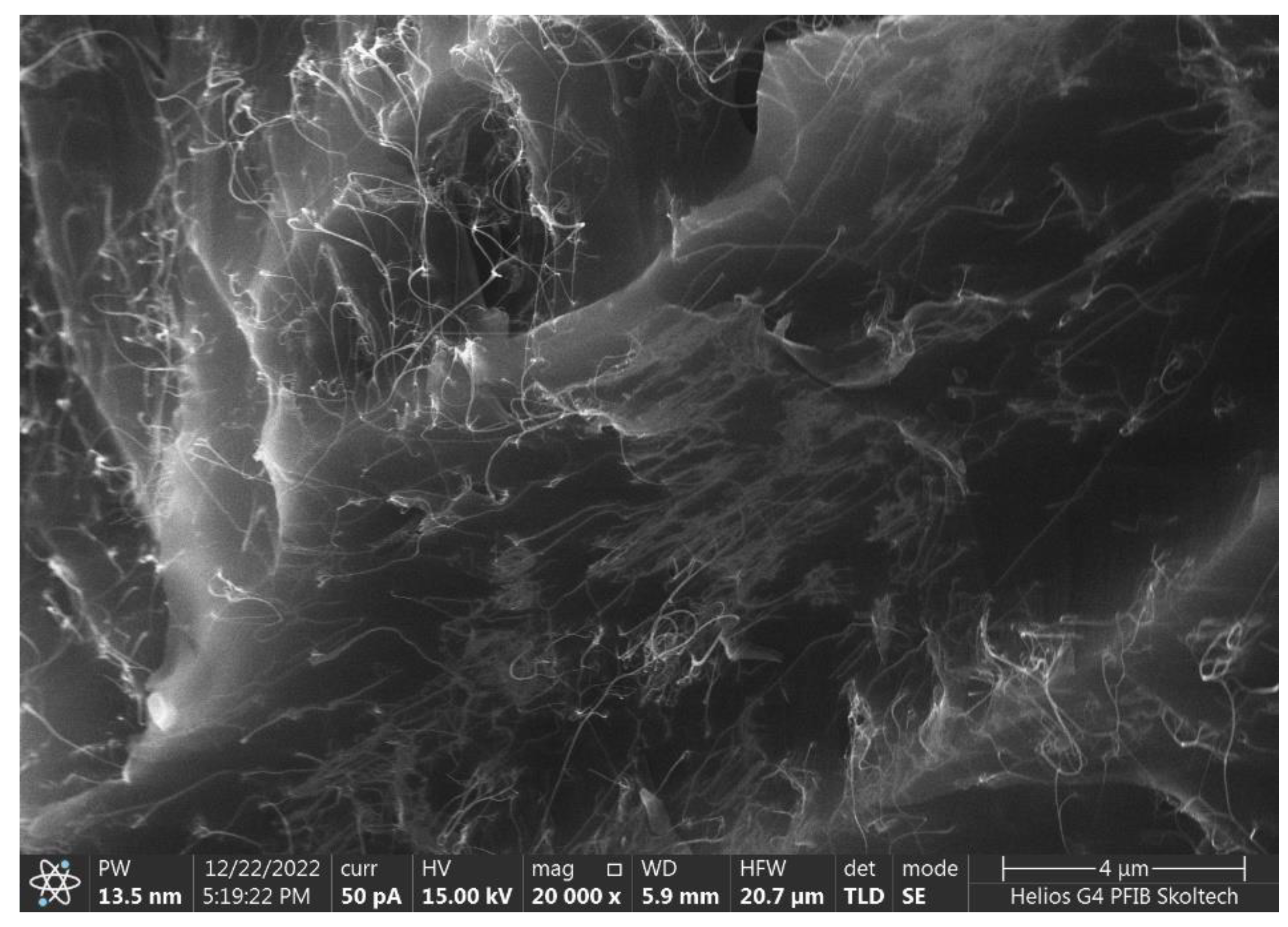
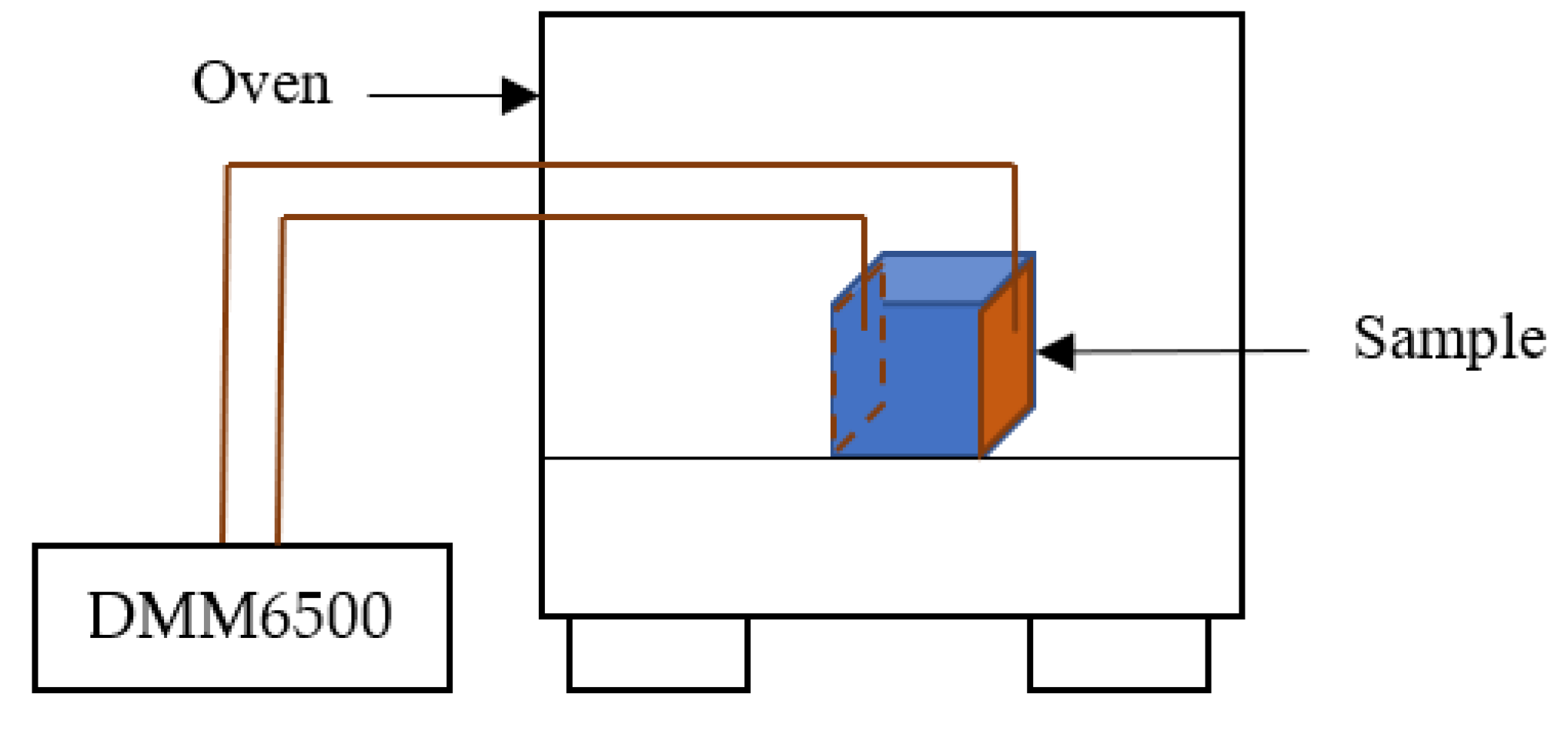
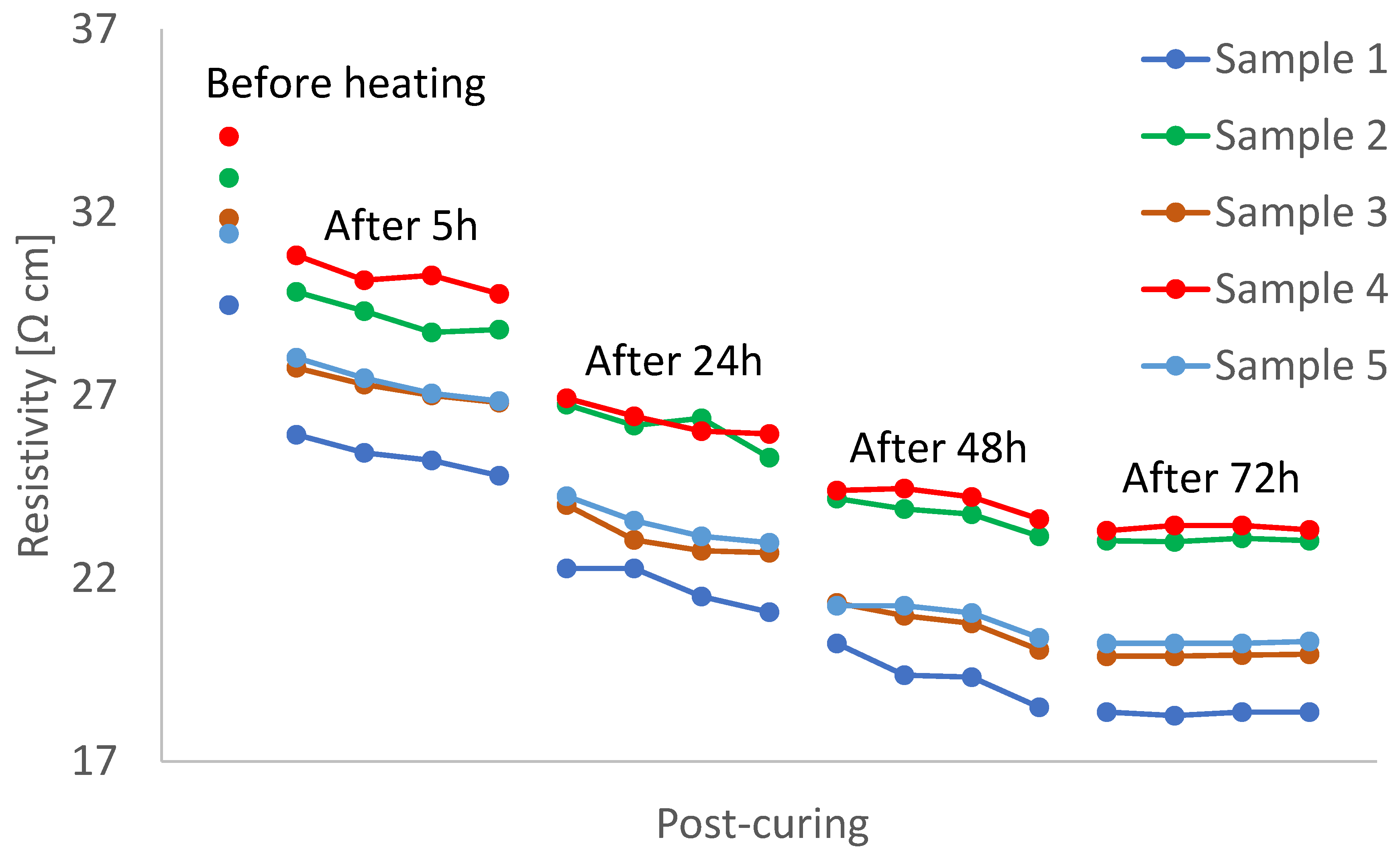


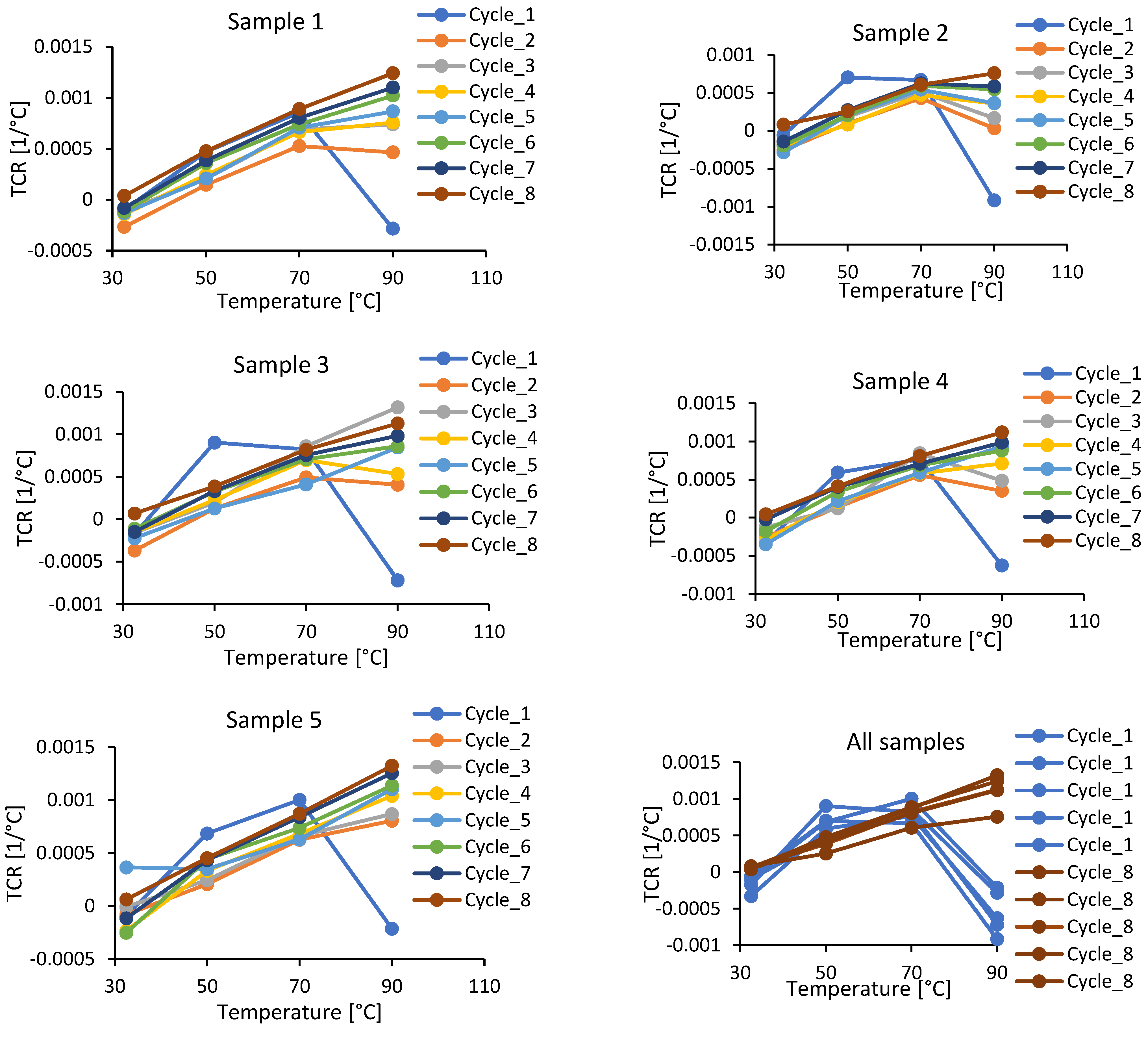
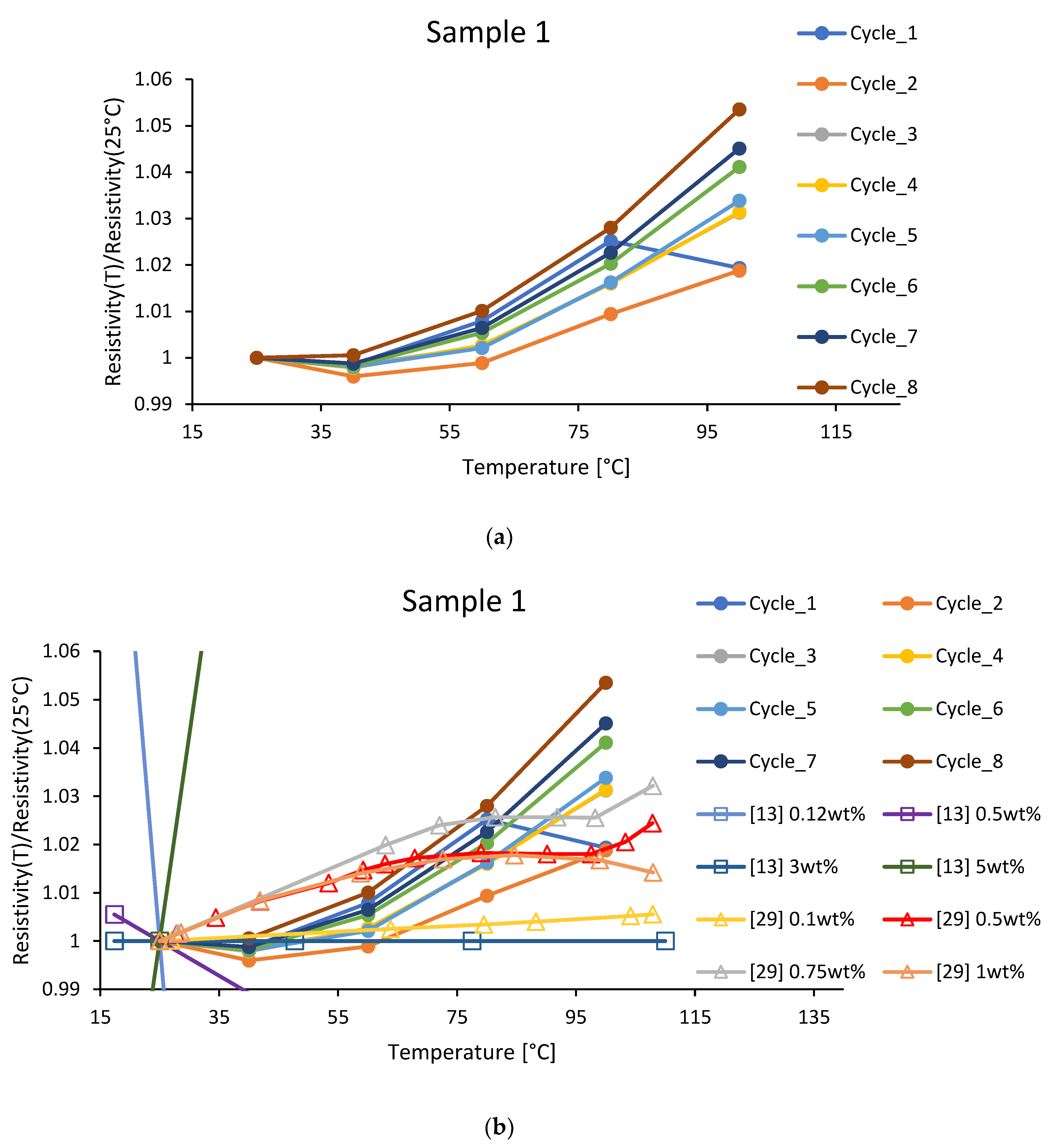
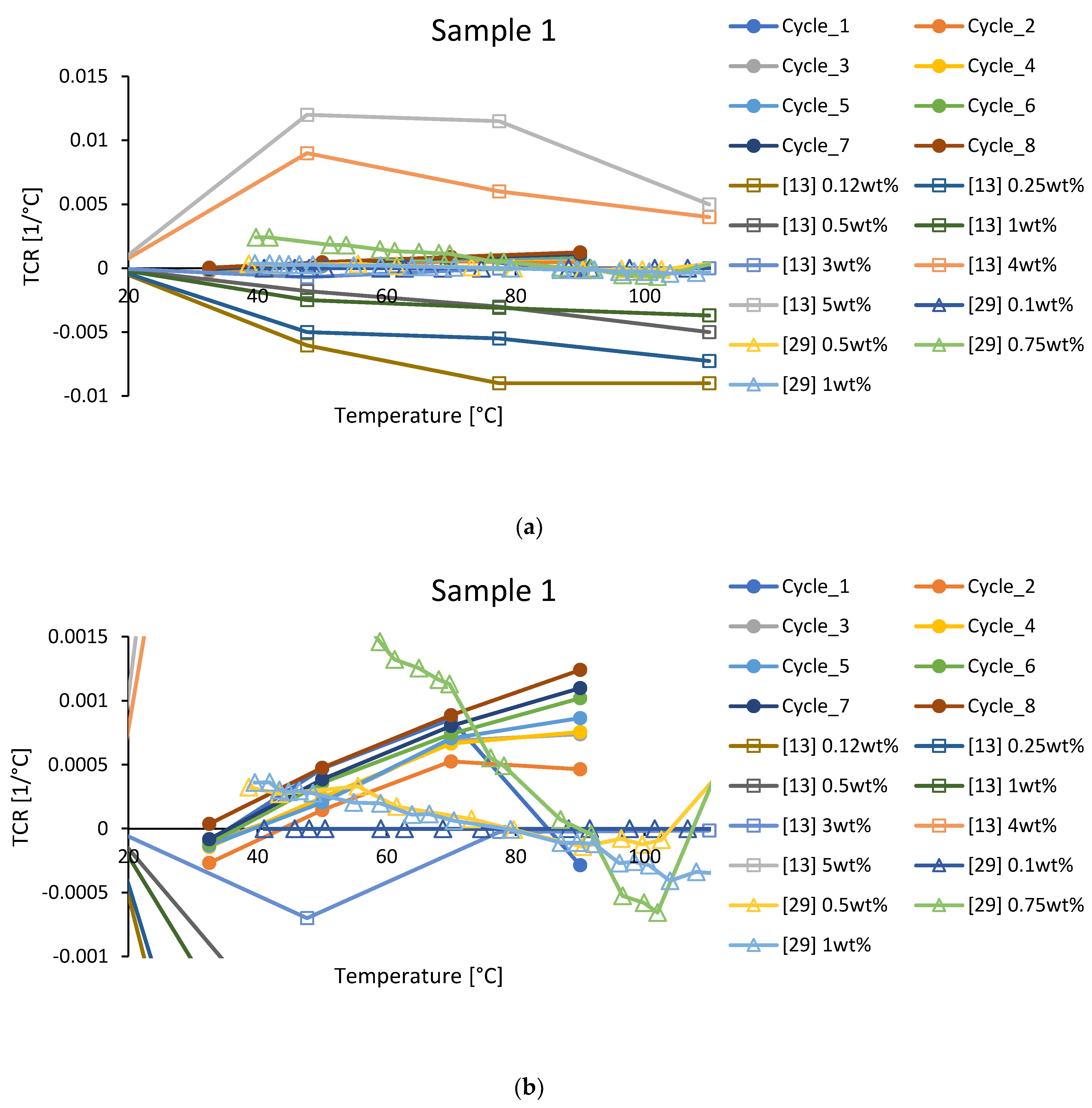
| Mixed Materials | Cycle 1 | Cycle 2 | Cycle 3 | |||
| Low speed + heating (45 °C) (20 min) | 15 min Vacuum | High speed + heating (45 °C) (60 min) | 15 min Vacuum | Low speed Without heating (20 min) | 15 min Vacuum |
| Sample | Resistance before Heating [Ω] | Resistance at the End of Program [Ω] | Relative Difference |
|---|---|---|---|
| 1 | 11.79 | 7.34 | 62% |
| 2 | 13.18 | 9.21 | 43% |
| 3 | 12.73 | 7.97 | 60% |
| 4 | 13.63 | 9.33 | 46% |
| 5 | 12.57 | 8.11 | 55% |
| Sample | TCR at Cycle 1, 90 °C [1/°C] | TCR at Cycle 8, 90 °C [1/°C] | Relative Difference |
|---|---|---|---|
| 1 | −0.00028 | 0.0012 | −535% |
| 2 | −0.00092 | 0.00076 | −183% |
| 3 | −0.00072 | 0.0011 | −257% |
| 4 | −0.00063 | 0.0011 | −278% |
| 5 | −0.00021 | 0.0013 | −717% |
| Source | Nanocomposite | Temperature [°C] | CNT Fraction | |
|---|---|---|---|---|
| CNT | Resin | |||
| Present study | SWCNT | epoxy | 25–100 | 0.6 wt.% |
| Gong et al. [13] | MWCNT | epoxy | −40–110 | 0.5 wt.% |
| Lasater et al. [29] | MWCNT | vinyl ester | 25–170 | 0.5 wt.% |
Disclaimer/Publisher’s Note: The statements, opinions and data contained in all publications are solely those of the individual author(s) and contributor(s) and not of MDPI and/or the editor(s). MDPI and/or the editor(s) disclaim responsibility for any injury to people or property resulting from any ideas, methods, instructions or products referred to in the content. |
© 2023 by the authors. Licensee MDPI, Basel, Switzerland. This article is an open access article distributed under the terms and conditions of the Creative Commons Attribution (CC BY) license (https://creativecommons.org/licenses/by/4.0/).
Share and Cite
Jafarypouria, M.; Mahato, B.; Abaimov, S.G. Separating Curing and Temperature Effects on the Temperature Coefficient of Resistance for a Single-Walled Carbon Nanotube Nanocomposite. Polymers 2023, 15, 433. https://doi.org/10.3390/polym15020433
Jafarypouria M, Mahato B, Abaimov SG. Separating Curing and Temperature Effects on the Temperature Coefficient of Resistance for a Single-Walled Carbon Nanotube Nanocomposite. Polymers. 2023; 15(2):433. https://doi.org/10.3390/polym15020433
Chicago/Turabian StyleJafarypouria, Milad, Biltu Mahato, and Sergey G. Abaimov. 2023. "Separating Curing and Temperature Effects on the Temperature Coefficient of Resistance for a Single-Walled Carbon Nanotube Nanocomposite" Polymers 15, no. 2: 433. https://doi.org/10.3390/polym15020433
APA StyleJafarypouria, M., Mahato, B., & Abaimov, S. G. (2023). Separating Curing and Temperature Effects on the Temperature Coefficient of Resistance for a Single-Walled Carbon Nanotube Nanocomposite. Polymers, 15(2), 433. https://doi.org/10.3390/polym15020433







